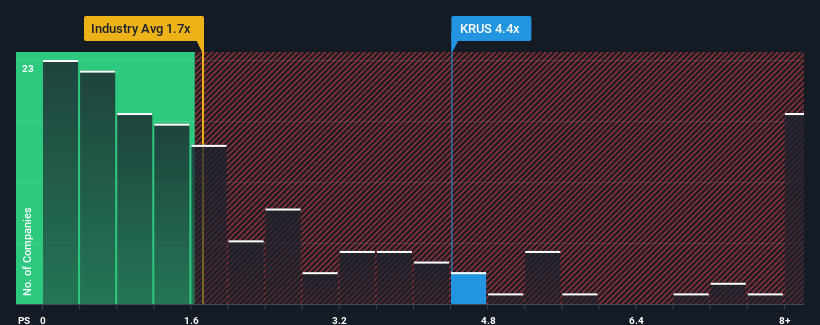
When close to half the companies in the Hospitality industry in the United States have price-to-sales ratios (or “P/S”) below 1.7x, you may consider Kura Sushi USA, Inc. (NASDAQ:KRUS) as a stock to avoid entirely with its 4.4x P/S ratio. Nonetheless, we’d need to dig a little deeper to determine if there is a rational basis for the highly elevated P/S.
View our latest analysis for Kura Sushi USA
What Does Kura Sushi USA’s P/S Mean For Shareholders?
Kura Sushi USA certainly has been doing a good job lately as it’s been growing revenue more than most other companies. It seems the market expects this form will continue into the future, hence the elevated P/S ratio. However, if this isn’t the case, investors might get caught out paying to much for the stock.
If you’d like to see what analysts are forecasting going forward, you should check out our free report on Kura Sushi USA.
Do Revenue Forecasts Match The High P/S Ratio?
The only time you’d be truly comfortable seeing a P/S as steep as Kura Sushi USA’s is when the company’s growth is on track to outshine the industry decidedly.
Taking a look back first, we see that the company grew revenue by an impressive 52% last year. Pleasingly, revenue has also lifted 125% in aggregate from three years ago, thanks to the last 12 months of growth. Therefore, it’s fair to say the revenue growth recently has been superb for the company.
Turning to the outlook, the next year should generate growth of 30% as estimated by the five analysts watching the company. That’s shaping up to be similar to the 31% growth forecast for the broader industry.
With this information, we find it interesting that Kura Sushi USA is trading at a high P/S compared to the industry. Apparently many investors in the company are more bullish than analysts indicate and aren’t willing to let go of their stock right now. Although, additional gains will be difficult to achieve as this level of revenue growth is likely to weigh down the share price eventually.
The Bottom Line On Kura Sushi USA’s P/S
It’s argued the price-to-sales ratio is an inferior measure of value within certain industries, but it can be a powerful business sentiment indicator.
Analysts are forecasting Kura Sushi USA’s revenues to only grow on par with the rest of the industry, which has lead to the high P/S ratio being unexpected. Right now we are uncomfortable with the relatively high share price as the predicted future revenues aren’t likely to support such positive sentiment for long. This places shareholders’ investments at risk and potential investors in danger of paying an unnecessary premium.
Don’t forget that there may be other risks. For instance, we’ve identified 3 warning signs for Kura Sushi USA (1 shouldn’t be ignored) you should be aware of.
If you’re unsure about the strength of Kura Sushi USA’s business, why not explore our interactive list of stocks with solid business fundamentals for some other companies you may have missed.
Have feedback on this article? Concerned about the content? Get in touch with us directly. Alternatively, email editorial-team (at) simplywallst.com.
This article by Simply Wall St is general in nature. We provide commentary based on historical data and analyst forecasts only using an unbiased methodology and our articles are not intended to be financial advice. It does not constitute a recommendation to buy or sell any stock, and does not take account of your objectives, or your financial situation. We aim to bring you long-term focused analysis driven by fundamental data. Note that our analysis may not factor in the latest price-sensitive company announcements or qualitative material. Simply Wall St has no position in any stocks mentioned.
Join A Paid User Research Session
You’ll receive a US$30 Amazon Gift card for 1 hour of your time while helping us build better investing tools for the individual investors like yourself. Sign up here







